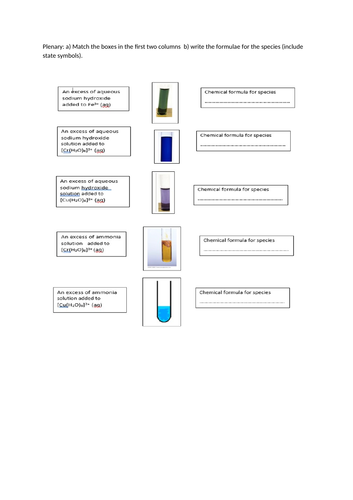



Student workbook and teacher PP for OCR A Level Chemistry A Year 2 Unit 24 Transition elements, Chapter 24.4 Precipitation and ligand substitution in complex ions, which could be used over* two lessons. *
The resource covers the reactions of Mn2+(aq), Cu2+ (aq), Fe2+ (aq), Fe3+ (aq) and Cr3+ (aq) with aqueous sodium hydroxide and ammonia solution;accompanying colour changes described; reactions described by ionic equations.
Examples of ligand substitution reactions discusssed using
[Cu(H2O)6]2+ and [Cr(H2O)6]3+ with ammonia and chloride ions.
The complexes compared in terms of colour change, shape and coordination number.
Importance of iron in haemoglobin, including ligand substitution involving O2 and CO is also discused.
The workbook contains lesson objectives, different type of tasks (including challenge tasks and stretch and challenge material) and assessment tasks (self-assessed and exam questions).
The PP for teachers supports the workbook and contains the answers to Tasks in Workbooks. The answers and explanations are revealed in steps.
The resources were prepared with the use of A Level Chemistry for OCR A text book. Many images /diagrams that appear in student workbook and on PP were taken from this book.
Some instructions in the workbook and the Summary questions (in assessment part of the booklet) refer to the above book.
Get this resource as part of a bundle and save up to 37%
A bundle is a package of resources grouped together to teach a particular topic, or a series of lessons, in one place.
Something went wrong, please try again later.
This resource hasn't been reviewed yet
To ensure quality for our reviews, only customers who have purchased this resource can review it
Report this resourceto let us know if it violates our terms and conditions.
Our customer service team will review your report and will be in touch.